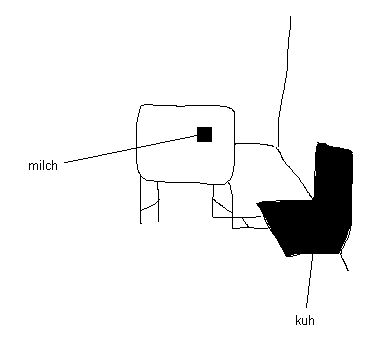
milk vs. cow
| S C H A L T E N U N D W A L T E N (Die Amme Die Amme 2/ The Wet-Nurse The Wet-Nurse 2) |
| Die Amme /The Wet-Nurse is a project from (or similar to)
the series SCHALTEN UND WALTEN, whose theme is the barrier.
The barrier stands between a possible event (but not a necessary one)
in the form of art and the object's possible viewer. The conditions for
the actual process, as well as the barrier itself, are set by the object.
The barrier's function is modelled on the switch. The Wet-Nurse is an object of administration, prevention, distraction
and silent economy. In other words, the Wet-Nurse is an interactive computer
installation, a approachable text, literature, a computer game, an oracle,
a semantic silhouette target, a laugh. The Nurse's advantage is that it can be and is used in any way following
current demand. When speaking to the computer, the conversation is not bound to any visible limitations other than the keyboard (this is an advantage rather than disadvantage). The computer is equipped with six language running devices: 1. The programmer, managing the events (the large belt). 2. The identification apparatus, made up of a word or group of words and a jungle of grammatical positions. Its job is to try to recognize the input. 3. The apparatus presiding over the situation; here the context is explored,
and a summed up self-assessment is given. 4. The reaction apparatus; a decision making machine which controls the accessability of the reaction supply and the answering tactics. 5. The reply supply; here is where the reply is taken from. 6. The reply forming apparatus; coordinates encyclopedias and educational instructions to form a reply. When and how things take place is determined in the course of the conversation.
Although the computer feigns to master the language, one gets the feeling
that it has a better memory and follows the conversation more closely,
than its human counterpart. The conversation touches on this and that or deals with the event of
switching. The event's carrier happens to be a glass of milk standing
on a table in a glass cabinet. The event is the knocking over of the glass,
the wasted milk on the table, the standing up of the glass, the refilling
of the glass and the return to its original standing position. Work on the Wet Nurse is completed when the glass finally stops falling over. The conversation with the computer is nothing more than useless talk,
(often) public speaking (where an individual representative, with a group
behind him, takes the floor, aiming his speach at an obvious opponent),
communication in form of collision and sometimes undefinable hopeful speach.
It is not certain with whom is beeing spoken; on a supperficial level
it appears to be the machine, - but everyone knows that this is total
rubbish. |
|
